
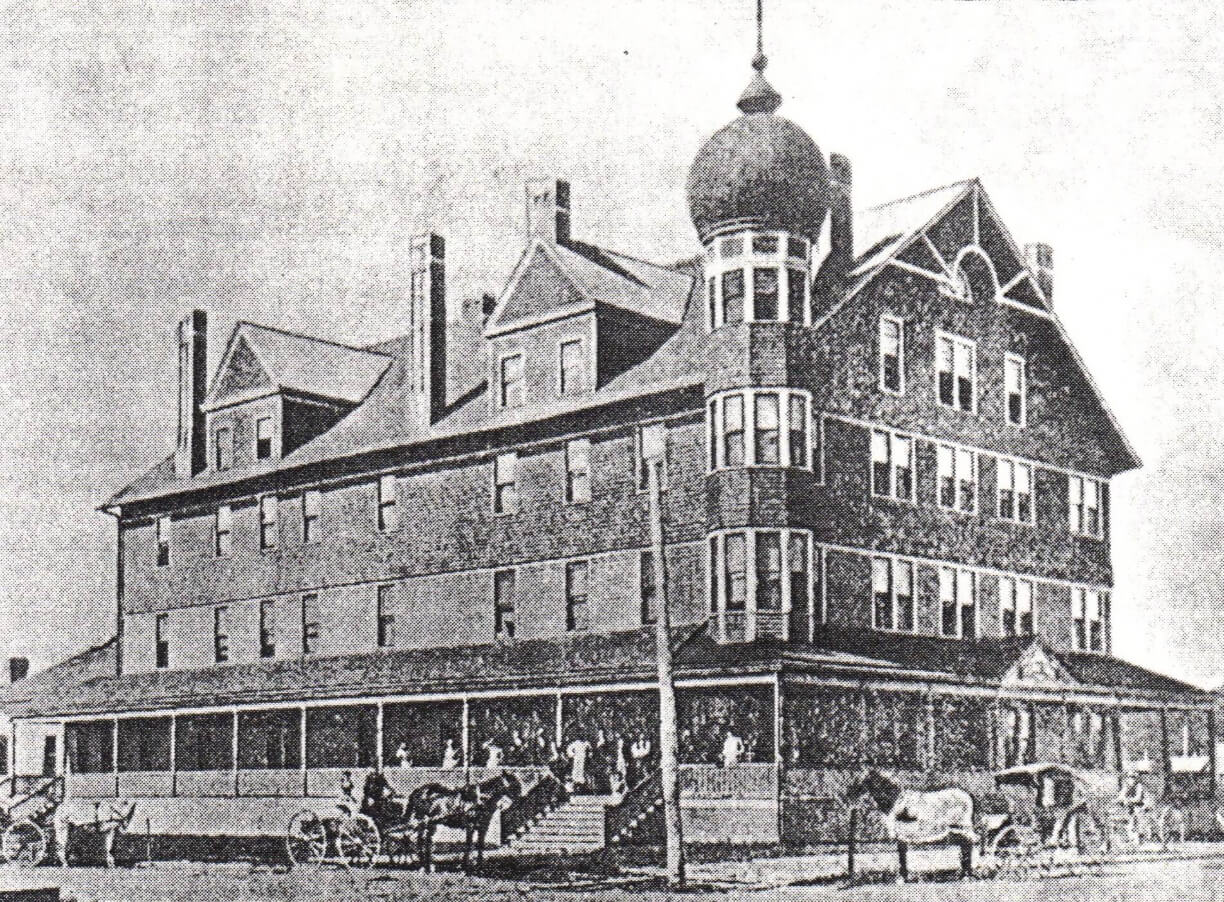
The York Inn built in 1891
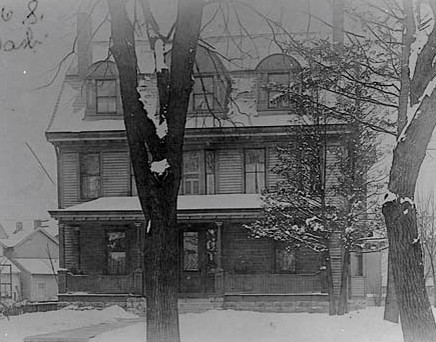
George and Marie Webster's home
built in 1902
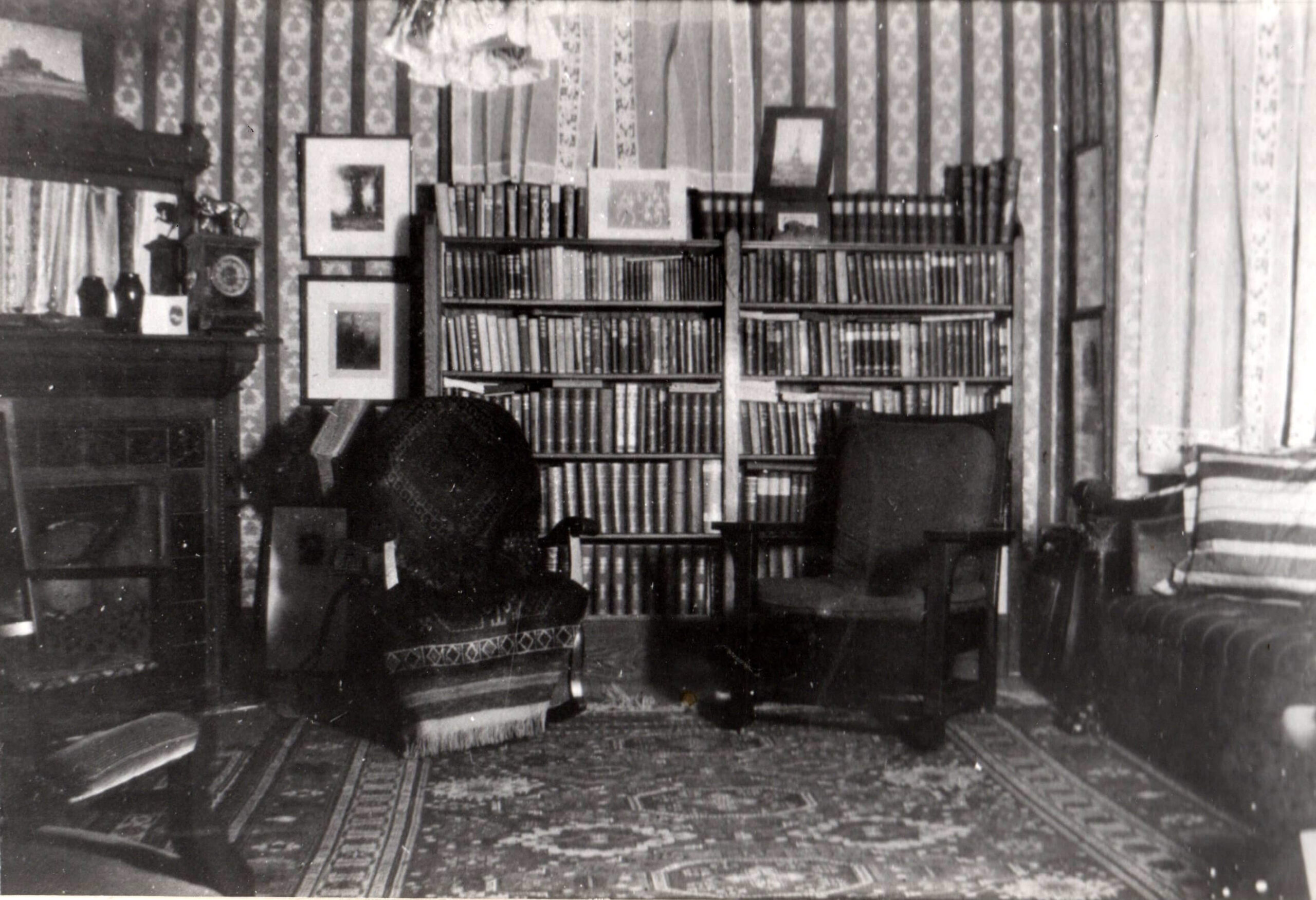
The back parlor
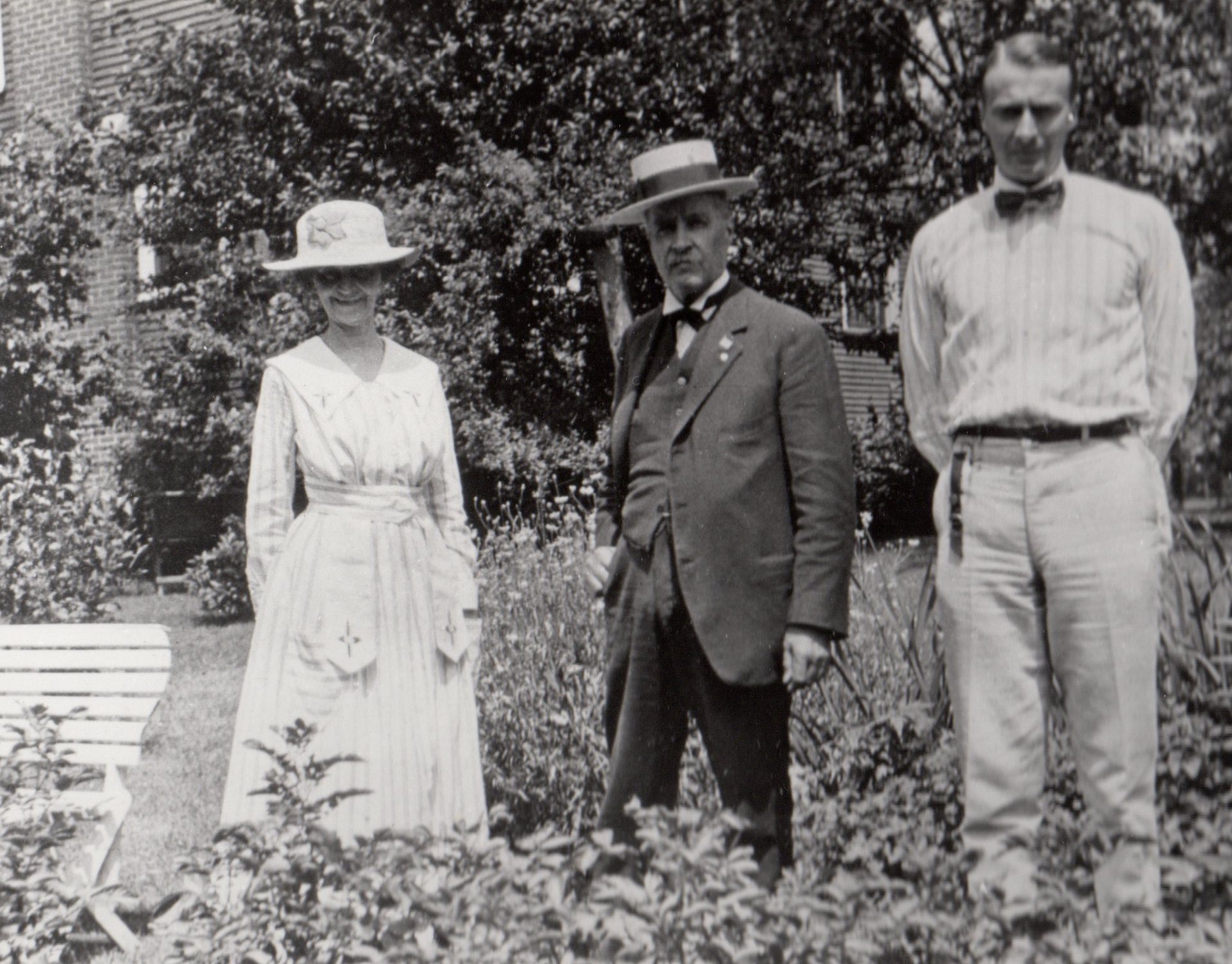
Marie and George Webster in their garden with their son, Lawrence
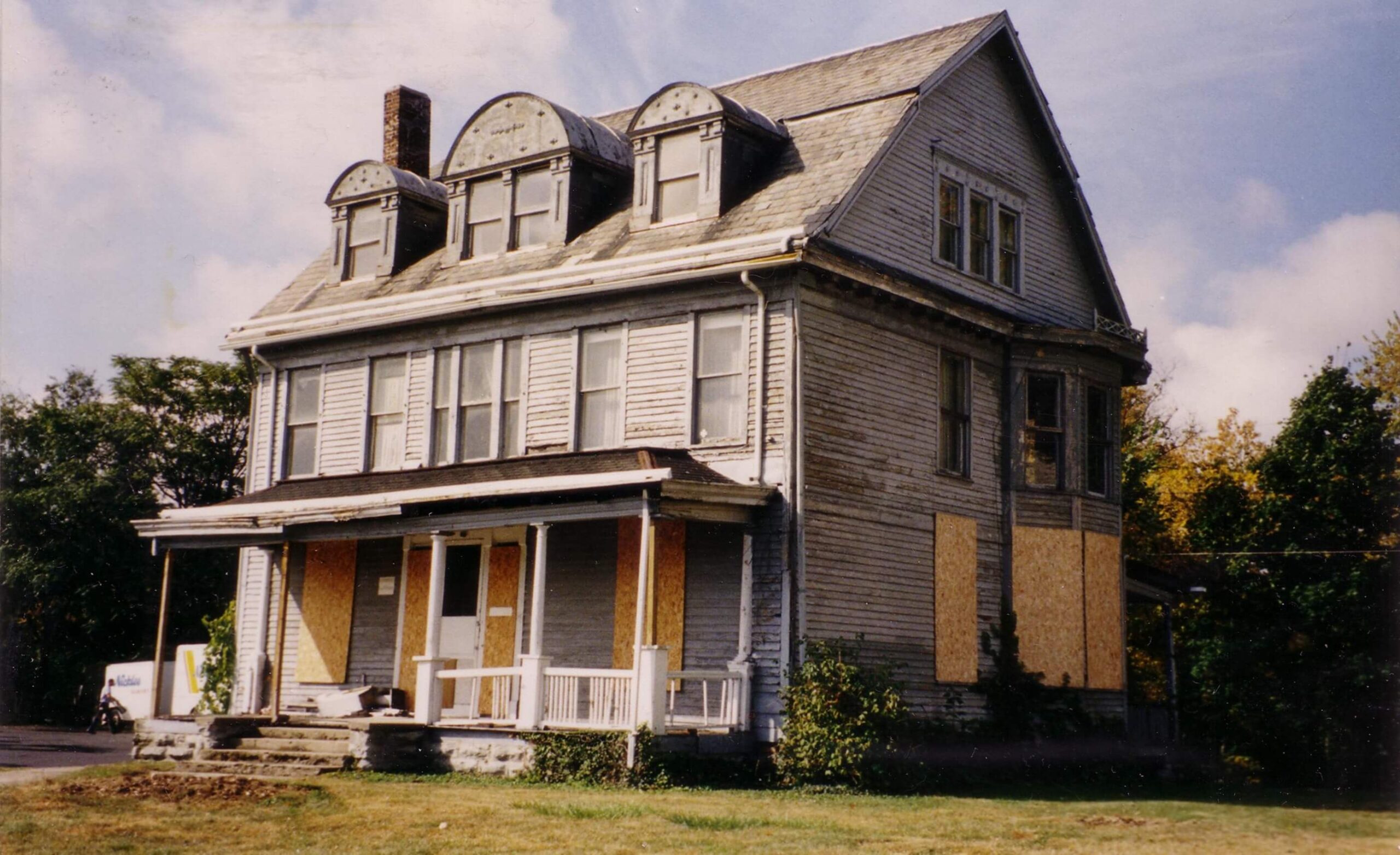
The Marie Webster House 1991
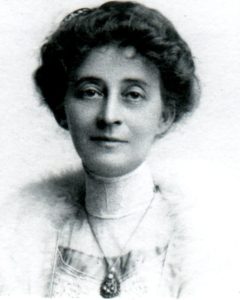
Marie Webster inducted into The Quilters Hall of Fame 1991
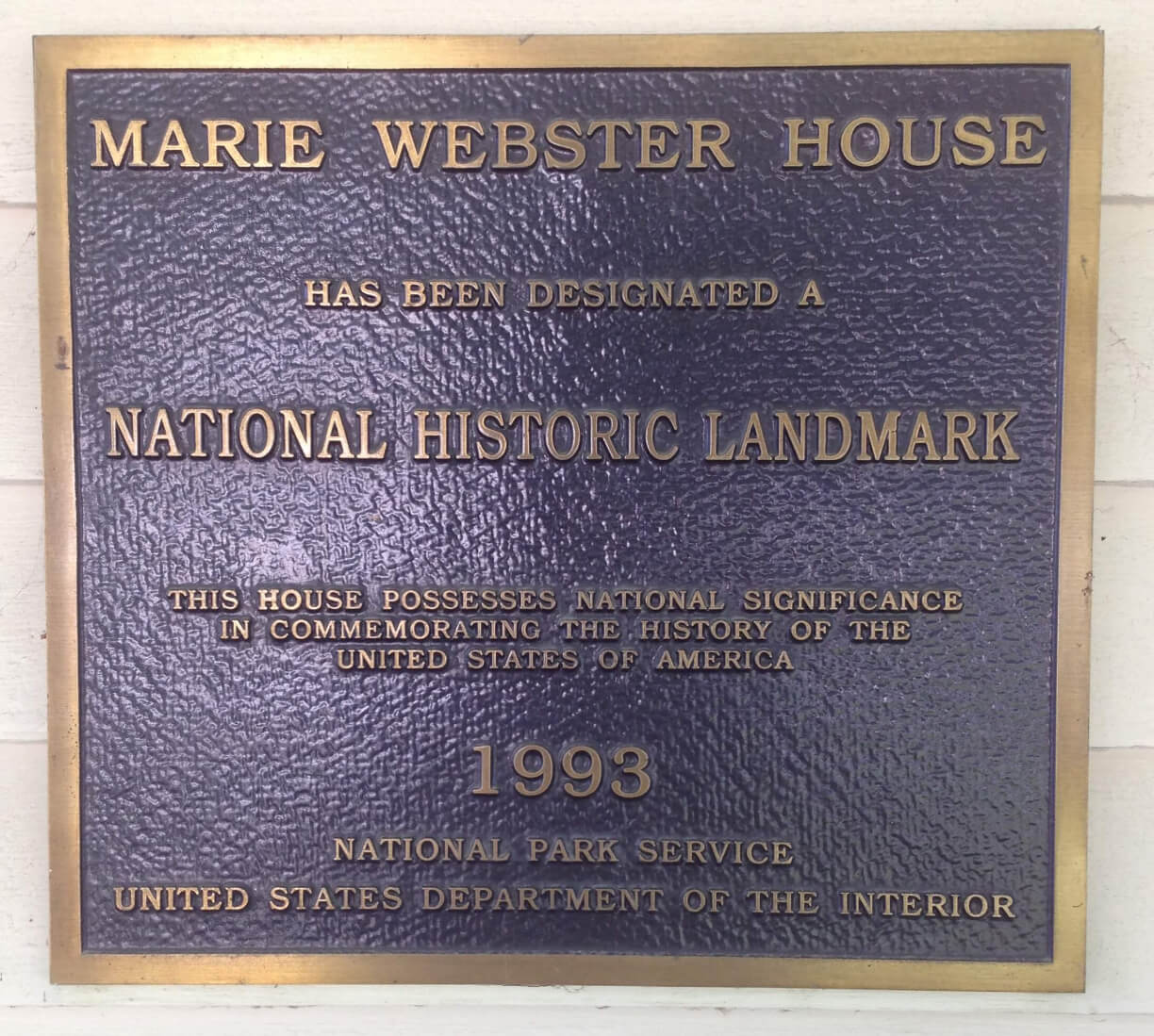

Marie Webster House in 1993
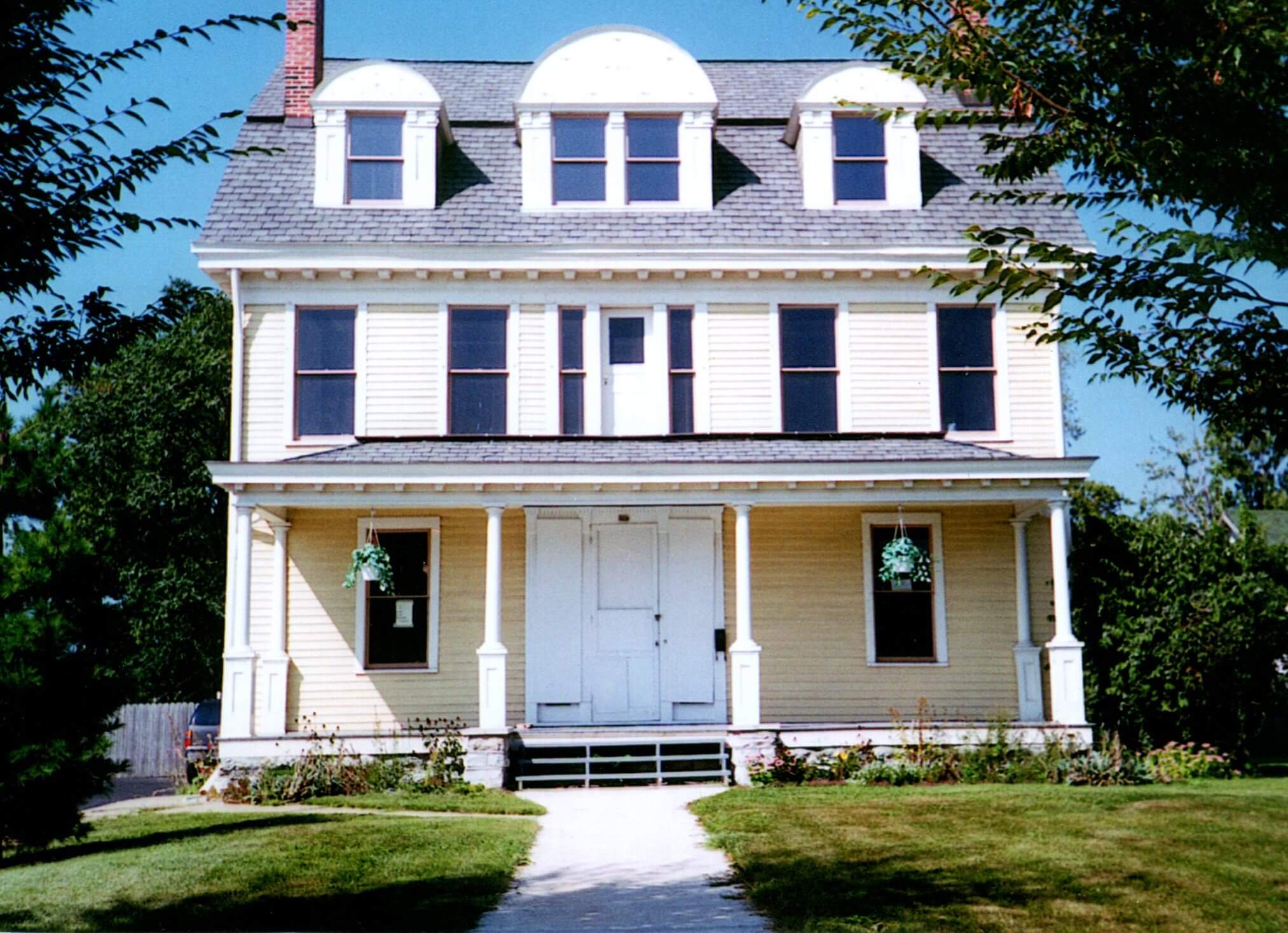
The Marie Webster house in 1994
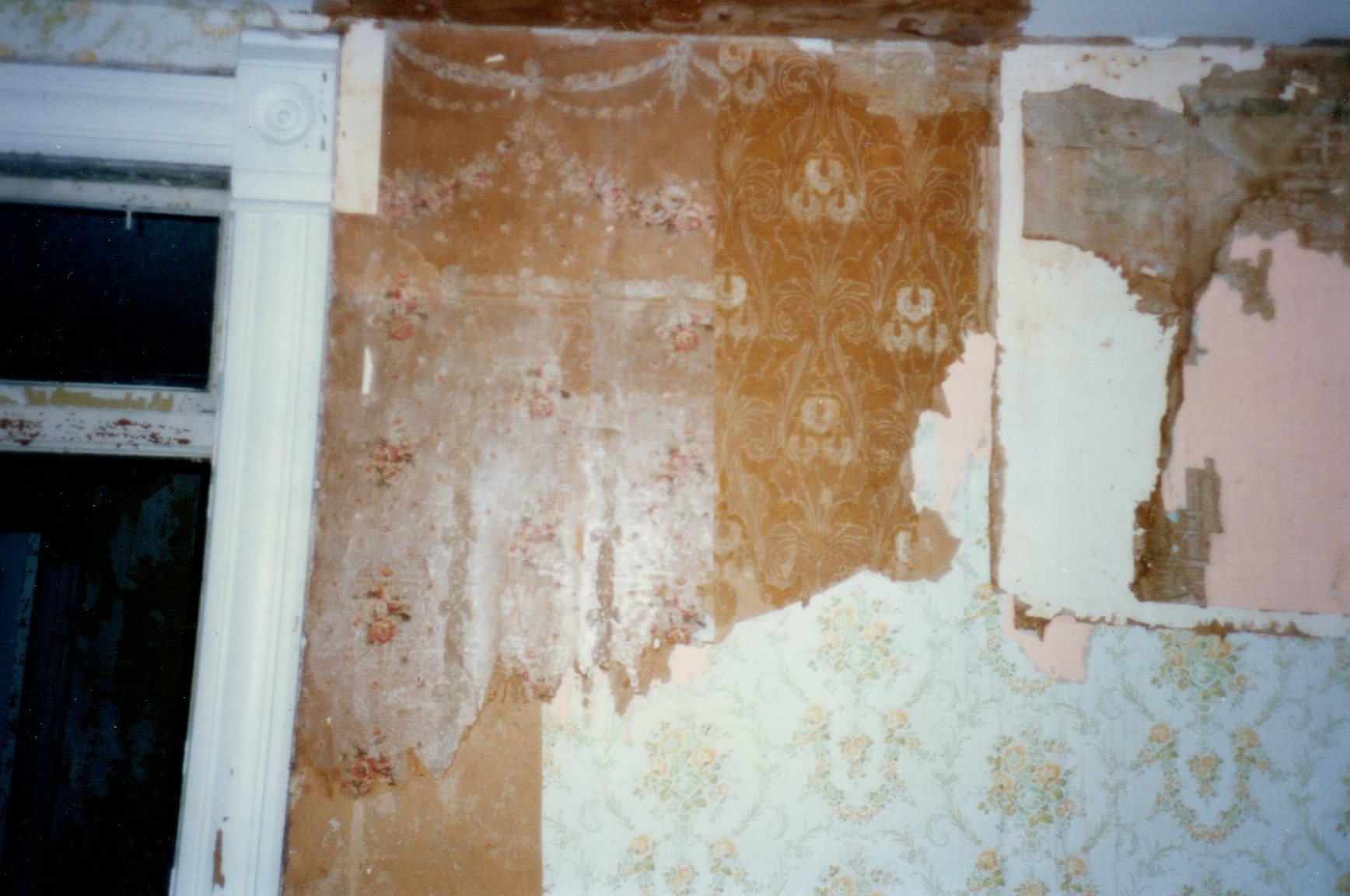
Layers of wallpaper
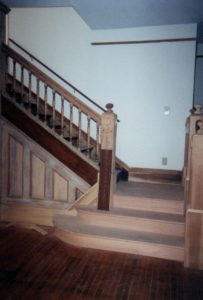

The Marie Webster House today
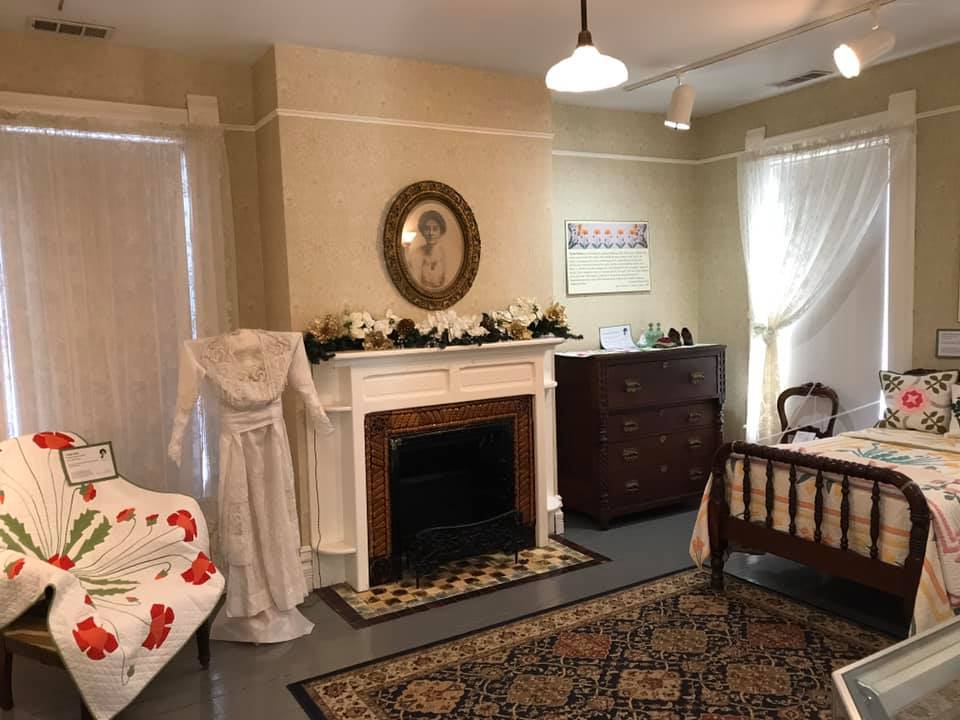
Marie's Studio today.

Marie's Grandaughter, Rosalind Webster Perry, in the garden behind the Marie Webster House.
The story of the Marie Webster house actually begins in 1887 with the discovery of natural gas just a few blocks away from the home's future location on South Washington Street in Marion, Indiana. The gusher's flames burst thirty feet into the air, while the sound of hissing gas could be heard in the Courthouse Square ten blocks away.
This dramatic event shaped the history of Marion, for it ushered in the "Gas Boom," marking a period of rapid development and great prosperity. Marion became know as "The Queen City of the Gas Belt" with gas lights left burning night and day. Free land and free gas were offered to lure new businesses to the area.
In 1891, the York Inn, a magnificent new four-story hotel, was built on the western edge of town to cater to the industrialists brought in by special train from the East. The heyday of the inn lasted only a few short years. The gas soon petered out, the entrepreneurs moved on, and the hotel went bust. It enjoyed a brief rebirth as a seventy-room sanitarium or "alcohol cure clinic," before being torn down in 1901. However, the construction materials, including the lumber and foundation stones, were purchased by Marion businessman, Lee Hall, for three new houses he was planning to build in the fashionable neighborhood just south of the town center. According to the local paper in April 1901, each of the houses would be "a modern and handsome structure and will add greatly to the beauty of the part of Washington Street, which now has a number of beautiful homes."
Marie and George Webster moved into one of the newly completed houses and hosted a memorable house warming on April 21, 1902. The Marion News Tribune reported, "Two hundred of the city's most representative people figured as guests of the Webster home during the afternoon and evening and the many beautiful gowns worn by the women presented a gorgeous spectacle." A program of musical entertainment was provided, which was re-enacted by the Quilters Hall of Fame at a party celebrating the centennial of the house, held in 2002 on July 19, Marie Webster's birthday.
Special features of the colonial revival home included a gambrel roof, dormer windows and a two-story gabled bay window. "Colonial" details were added: a porch with Tuscan colonnettes, a modillion cornice and leaded glass windows. The back porches sported Victorian columns recycled from the York Inn.
Inside, the stair hall was the central focus with a double parlor, dining room and kitchen beyond. Tiled fireplaces provided heat to the main rooms. Upstairs, four rooms and a bathroom opened off a central hallway. The two north facing rooms connected to form a bedroom and sitting room suite. It was this sitting room that would become Marie Webster's sewing room and studio when she started designing and selling quilt patterns. Here she made her quilts, produced patterns for sale, welcomed customers, and wrote the first book of quilt history, Quilts: Their Story and How to Make Them, published in 1915.
The house was furnished in a mixture of Victorian and Arts and Crafts styles. A wicker settee and chairs stood in the entrance hall and oriental rugs covered the oak floor, with dark green drapes hung at the windows and across the doorways. Various floral wallpapers decorated the upstairs bedrooms, their styles changing along with changing fashions from Victorian, to Arts and Crafts, to Art Deco of the 1920s.
Marie and George Webster made their home here for the next 36 years. In 1922 they were joined by Marie's unmarried sister, Emma Daugherty, and in the 1930s, their son Lawrence and his wife Jeanette lived in the third floor "penthouse" for several years before their children were born. George died in 1938, but Marie and Emma continued to live here until 1942 when they moved to New Jersey to be with Lawrence and his family. At that time, they sold the house to their next door neighbors, who converted it into five apartments.
Our family knew nothing of the fate of the house until 1988, when I returned to Marion for the first time since our family moved away in 1942. What inspired me to go back after such a long time? I had recently learned that Marie Webster was well known to quilters for her book and for her floral applique quilt designs, which were still appearing in quilting magazines thirty years after her death. I decided to publish a new edition of her book, which would feature her biography. I realized how important it would be to visit Marion to seek out information about my famous grandmother.
I was filled with anticipation as I drove my rented car down Marion's main street, not knowing what I would find. My delight at seeing the old family home at 926 South Washington Street still standing was eclipsed when I saw the dreadful condition of the house and yard. Weeds stood six feet tall and lush vines appeared to be dragging the front porch down to the ground. The porch was literally at the point of collapse, as I soon discovered when I climbed up the steps to ring the doorbell. Before I even reached the front door, the porch gave way, and much to my surprise I found myself sprawled on the porch with one leg trapped between the rotten floor boards. As I extricated myself, luckily uninjured, I was determined to find out who owned the property and how it had come to this sorry state.
I managed to locate the owner who showed me the inside of the building, which had been vacant for about five years. After I returned to California, we kept in touch. She sold the house to a family who planned to fix it up. But in the fall of 1990, the new owner informed me that it had been condemned by the City of Marion as a "public nuisance." He had changed his mind about repairing it: would I like to buy it? Otherwise, if would have to be torn down. The drive-in restaurant next door wanted to acquire the land to enlarge its parking lot.
Marie Webster had been nominated to The Quilters Hall of Fame, her quilts were appreciated as never before. What a shame if her home were torn down! Since the price was very low, I was able to purchase it, forestalling its demolition. To remove it from the list of condemned properties, I was required to write a letter to the City, promising that I would "bring it up to code." At that point, I had no plan of how to fulfill that pledge. I contacted several community groups, hoping to find one that would be able to fix up the house and use it.
Shortly after I acquired the deed for the house, I traveled to Sacramento, California, in July 1991, for the West Coast Quilters Conference, where the induction of Marie Webster into The Quilters Hall of Fame would take place. I had a sudden thought: The Quilters Hall of Fame- perhaps they could use the home of an Honoree?
When I first met Hazel Carter at the conference, I exclaimed, "Would you like to put The Quilters Hall of Fame in Marie Webster's house in Indiana?" Much to my amazement, her reaction was enthusiastic. And thus began our collaboration on the challenging project.
But what a herculean task lay ahead! The house was quite dilapidated and it would be expensive to do all the necessary renovation. We would need plenty of help. Expert advice was essential. I contacted an historic preservation consultant, Craig Leonard, who recommended applying for listing on the state and national historic registers, to provide some measure of protection. He researched and prepared the necessary documentation.
On April 22, 1992, "The George Jr. and Marie Daugherty Webster House" was entered in the Indiana Register of Historic Sites and Structures, and on June 17, 1992, it was listed in the National Register of Historic Places. With the historical significance of the building officially recognized, I transferred the deed to The Quilters Hall of Fame on October 8, 1992.
We soon learned that the National Park Service was conducting a survey of structures related to women's contributions. We were delighted when the Marie Webster House was selected as a Landmark of Women's History and was officially declared a National Historic Landmark, the highest designation bestowed by the United States Government.
Hazel Carter received the news in a letter from Edwin C. Bearss, Chief Historian:
"I am please to inform you that the Marie Webster House in Marion, Grant County, Indiana, has been found to possess national significance in the history of the United States. As a result, the Secretary of the Interior has designated it a National Historic Landmark on November 4, 1993."
It was important to find people in the local community who would support this project. I wrote a letter to the local paper, inviting people interested in preserving the house to contact me. I soon heard from Phebe Smith, a long-time resident of Marion, whose parents happened to live near me in Santa Barbara, California. Phebe spearheaded a new group, The Friends of The Quilters Hall of Fame, which has grown and thrived.
The dedication and hard work of this stalwart band of volunteers is largely responsible for the successful completion of the restoration work on Marie Webster House and for the blossoming of quilt activities locally. The Friends started a new quilt group, The Marie Webster Quilt guild, and sponsor many quilting and fund-raising activities, including an annual Christmas Quilt Show and a National Quilting Day event. They work tirelessly throughout the year to plan and host our major four-day Quilt Celebration in July.
Renovation
Condemned as a health and safety hazard, the Webster House was clearly in need of a major overhaul. As work progressed over the next ten years, just how much help it needed became clear.
The highest priority was to replace the original roof, to stop the leaks that were continuing to damage the interior. Then we received several grants to repair all the ornamental trim, brackets, cornice, siding and especially my nemesis, the sagging front porch. Next, the exterior was painted in the original color scheme, yellow with cream trim.
That phase of the project was completed in 1994, shortly before our National Historic Landmark celebration. On July 15, 1994, a large group gathered beside the front porch to view the unveiling of the landmark plaque by a representative of the National Park Service. The mayor of Marion, the Director of the Indiana Department of Natural Resources, and representatives of the Historic Landmarks Foundation of Indiana and the National Trust for Historic Preservation and other dignitaries also spoke.
In 1995, Craig Leonard undertook a study of the historic wall-papers in the house, with a Preservation Services Fund grant from the National Trust for Historic Preservation. His goal was to accumulate a complete set of papers - wall, frieze, and ceiling - for every room in the house. His task was complicated by the years of roof leaks that had ruined many of the interior walls, and by the alterations make to the house when it was divided into apartments. Fortunately, many wallpapers survived underneath the additions. Working with a hand-held steamer and a tiny surgical scalpel, Craig was able to recover samples of styles ranging from delicate florals and Art Nouveau designs to textured solid color "oatmeal" papers.
In 1996, we received a grant to renovate the windows, which were in a sad state of repair, from the National Park Service under a program administered by the Indiana Department of Natural Resources, Division of Historic Preservation and Archaeology. Matching funds were provided by numerous donors to our capital campaign and by grants from the Gannett Foundation and the Grant County Convention, Recreation and Visitors Commission. Most of the windows were repaired or replaced, including two elegant leaded glass windows beside the front door.
Members of the Building Committee helped take down, bundle and store much of the original woodwork, which was eventually reinstalled and refinished in 2004. All the old lath and plaster, damaged beyond repair by many winters without heat, was removed by the Grant County Jail Work Release crew. Consultant Craig Leonard coordinated these difficult and messy jobs.
We hired an architect to oversee the interior work, George Morrison of Morrison Kattman Menze, Inc., in Fort Wayne, Indiana. His investigations showed that the house was not structurally sound. New beams were needed to support the sagging floors in several rooms. This work was completed in 1997, while the architect prepared comprehensive plans for all the mechanical systems: New plumbing, wiring, a new heating system and, for the first time, air-conditioning! To bring the building up to date, we would add telephone, alarm, cable and computer wiring, and a fire protection sprinkler system. Fundraising to pay for all these expensive improvements kept everyone busy until 1999, when this phase of the work got underway. In 2001, the house, with its array of modern systems in place, was finally ready for the interior walls to be replaced.
We made some changes to the floor plan, to accommodate the building's new role as museum and research center. An accessible restroom would occupy the former kitchen, while the original dining room would become the museum store. The third floor would serve as our collections area and archives. Marie's studio would be restored as a period room of the early 1900s, and the remaining rooms would hold exhibits, office and library.
A new ramp leading up to the front porch was added, just in time for the Centennial Housewarming Party on July 19, 2002. The third floor was completely renovated in 2003. Now the work is nearing completion: Period light fixtures, track lighting and carpets have been selected, the woodwork has been reinstalled and refinished and the wallpaper hung in Marie's studio- all the final touches needed for the Grand Opening on July 16, 2004.
Absolutely essential to this long restoration process is our Building Committee, under Chairman Scott Shepler and Secretary Madonna Fowler. Other members are Jean Chambers, Frieda Faulk, and Joe Musser. Former members, including Richard Fowler, Rex Chambers, Mary and Norm Cheek, Craig Leonard, Liz Dolgner and Margaret Thomas, also provided vital, and often hands-on, assistance.
In addition to her jobs as Board Secretary and Secretary of the Building Committee, Madonna Fowler serves as our Site manager, working closely with the contractor, JG Bowers, Inc., to complete all the complex tasks involved in rescuing this historic structure and transforming it into a state-of-the-art museum and research center. She deserves a tremendous "thank you" for her dedication to turning dreams into realities.
But the old house still holds surprises! As the stain was being stripped from the pair of pocket doors leading into the grand parlor, the words "Hotel Office" appeared in the doors in ghostly silhouette. This new discovery brings the house full circle- back to the 1890s, when these doors were a part of the grand York Inn.

